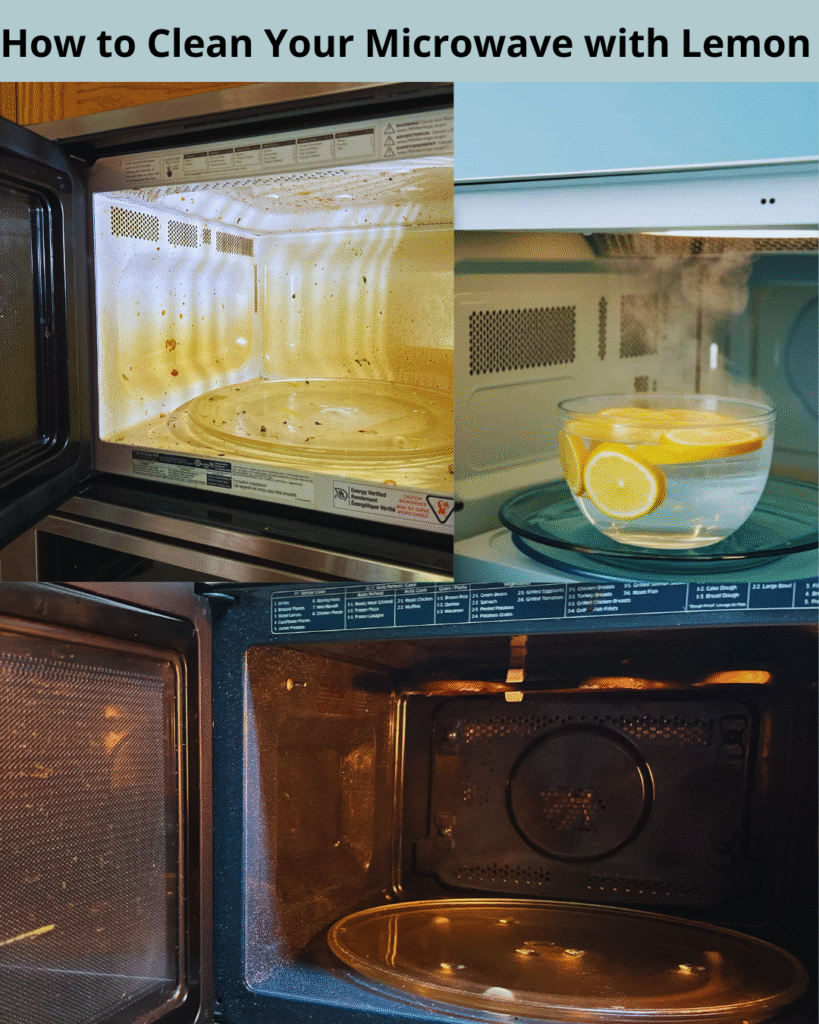Table of Contents
Picture this: It’s 11 PM, and I’m standing in my dimly lit kitchen, staring at what can only be described as a microwave massacre. My teenage son’s attempt at reheating leftover pizza had gone horribly wrong, leaving behind a Jackson Pollock masterpiece of cheese and tomato sauce across every interior surface. As I contemplated the industrial-strength cleaners lurking under my sink, my grandmother’s voice whispered through my memory: “Mija, when you have lemons, you have magic.” That night, I discovered how to clean your microwave with lemon – a revelation that transformed my most dreaded cleaning task into something I actually look forward to. This simple, natural method doesn’t just clean; it restores your faith in the power of humble kitchen ingredients.
Why You’ll Love This Natural Cleaning Method
Effortlessly Easy and Time-Saving: This homemade cleaning solution requires zero scrubbing and minimal hands-on time. While the lemon steam works its magic, you’re free to tackle other kitchen tasks or simply enjoy a well-deserved coffee break. It’s the ultimate family-friendly cleaning hack that even kids can safely help with.
Completely Chemical-Free and Safe: Say goodbye to harsh fumes and toxic residues that might contaminate your food. This natural approach uses only ingredients you’d happily eat, making it perfect for households with children, pets, or anyone with chemical sensitivities.
Budget-Friendly Kitchen Solution: At less than 50 cents per cleaning session, this method costs a fraction of commercial microwave cleaners while delivering superior results. Your wallet will thank you as much as your sparkling clean appliance.
Eliminates Stubborn Odors: Beyond surface cleaning, lemon naturally neutralizes even the most persistent food smells – from fishy leftovers to burnt popcorn disasters. Your microwave will smell like a Mediterranean citrus grove for days.
Versatile Cleaning Power: Whether you’re dealing with dried cheese explosions, splattered pasta sauce, or mysterious sticky spots that seem to multiply overnight, this technique tackles it all with remarkable ease.
Essential Ingredients and Smart Selection Tips
The hero of this cleaning method is fresh lemon, nature’s most powerful degreasing agent. While bottled lemon juice works in emergencies, fresh lemons contain higher concentrations of natural citric acid and essential oils that boost cleaning effectiveness while providing that incredible aromatherapy experience. When shopping, choose lemons that feel heavy for their size with bright, smooth skin – these contain maximum juice and active cleaning compounds.
Pure water serves as your steam delivery system, carrying the lemon’s cleaning power to every corner and crevice. If your tap water is particularly hard or mineral-heavy, consider using filtered water to prevent any spotting on interior surfaces.
Optional white vinegar can supercharge your cleaning power for particularly challenging situations. The acetic acid works synergistically with lemon’s citric acid, creating a powerhouse combination that dissolves even the most stubborn grease and food buildup.
For optimal freshness, store lemons at room temperature for up to one week, or refrigerate for extended storage up to one month. Room temperature lemons yield more juice and release oils more readily. If using bottled lemon juice, refrigerate after opening and use within six months for peak potency. Pro tip: roll room-temperature lemons firmly on your counter before cutting to maximize juice extraction.
Key Techniques and Method Mastery
Perfect Steam Generation: Success hinges on creating the ideal amount of steam – enough to penetrate dried food particles without creating a mess. The magic ratio is half a cup of water, which generates optimal steam pressure in most standard microwaves without risk of overflow or inadequate coverage.
Precision Timing Method: Heating for exactly 2-3 minutes activates the citric acid while creating maximum steam penetration. This precise timing prevents the water from boiling away completely while ensuring the lemon releases its full cleaning potential. Under-timing leaves you with insufficient steam; over-timing can cause dangerous superheating.
Critical Resting Period: The most overlooked yet essential technique is the 5-minute waiting period after heating. This resting time allows steam to work its magic, softening even cement-like food splatters without any physical scrubbing. Resist the temptation to open the door early – patience is your secret weapon.
Strategic Wiping Technique: Using microfiber cloths ensures you capture loosened debris without scratching delicate interior surfaces. Always wipe in systematic circular motions, starting from the ceiling and working downward to prevent recontaminating cleaned areas. The gentle abrasion of microfiber combined with the lemon’s natural oils creates a streak-free finish.
Understanding these techniques transforms cleaning from a chore into a satisfying ritual where science meets practicality.

Step-by-Step Cleaning Instructions
Step 1: Slice one fresh lemon in half and squeeze both halves into a microwave-safe bowl, catching all the precious juice. Drop the squeezed lemon halves directly into the bowl – they’ll continue releasing oils and cleaning compounds during the heating process. Add exactly half a cup of water to create the perfect steam-to-acid ratio.
Step 2: Position the bowl in your microwave’s center and set power to high. Heat for 2-3 minutes, adjusting based on your microwave’s wattage. You’ll know it’s working when condensation fogs the window and that unmistakable fresh citrus aroma begins wafting from the vents.
Step 3: When the timer stops, exercise superhuman patience and leave the door closed for a full 5 minutes. Listen for the gentle bubbling sounds as the steam continues its work. This waiting period is non-negotiable – it’s where the real magic happens.
Step 4: Carefully remove the bowl using oven mitts, as both the ceramic and water will be scalding hot. As you open the door, you’ll be greeted by a rush of lemony steam that instantly signals success.
Step 5: Armed with a damp microfiber cloth, begin your victory lap starting with the microwave ceiling. Work in overlapping circular motions, marveling at how effortlessly even stubborn, dried-on food particles dissolve away. Pay special attention to the turntable, door interior, and often-forgotten rubber door seal where odors love to hide.
Step 6: Don’t waste that golden lemon water! Use it to wipe down the exterior control panel, handle, and surrounding surfaces. The natural oils will leave everything gleaming with a subtle, fresh scent.
Pro Tips and Troubleshooting Secrets
Maximize your lemon investment: That heated lemon water is liquid gold for cleaning other appliances. Use it on your stovetop, microwave exterior, stainless steel surfaces, or even as a natural garbage disposal freshener.
Power-adjust for your microwave: High-wattage units (1000+ watts) may only need 2 minutes, while lower-powered microwaves benefit from the full 3 minutes. Start conservative and adjust – you can always add more time.
Pre-treat stubborn problem areas: For particularly challenging spots, dab concentrated lemon juice directly onto trouble areas before beginning the steam process. This targeted pre-treatment breaks down grease and food particles more effectively.
Temperature optimization trick: Cold lemons from the refrigerator release less juice and fewer oils. Let them reach room temperature, or roll them firmly on your counter while applying pressure to break down internal membranes before cutting.
Weekly maintenance prevents major cleanups: Incorporate this method into your regular kitchen routine. When performed weekly, you’ll only need 2 minutes of steam time and minimal wiping – it becomes almost effortless.
Creative Variations and Customizations
Transform your cleaning experience with aromatic additions like a few drops of vanilla extract mixed into your lemon water. This creates an incredibly pleasant scent that’s especially welcome after cleaning up fishy or heavily spiced food remnants.
For heavy-duty situations, create a power mixture using equal parts fresh lemon juice and white vinegar with your water. This combination provides extra cutting power for extreme grease buildup or long-neglected microwaves.
Gentle approach for newer appliances involves using only lemon juice and water without the lemon halves, reducing concentration while maintaining effective cleaning power.
Large microwave adaptation requires scaling up: use one whole lemon with three-quarters cup water and extend heating to 4 minutes for oversized or commercial units.
Smart Storage and Maintenance Strategies
Immediate follow-up advantage: While your microwave remains warm and humid from the cleaning process, it’s the perfect time to address any remaining spots. The residual moisture makes even stubborn areas wipe away effortlessly.
Establish a weekly rhythm: Make this your go-to weekly kitchen maintenance routine. Regular cleaning prevents buildup, meaning future cleanings require only 2 minutes of steam time – practically effortless.
Lemon preservation wisdom: After using half a lemon, store the remainder cut-side down on a plate in your refrigerator. It stays fresh for up to one week and can be used for cooking or your next cleaning session.
Preventive microwave care: Maintain optimal appliance function by covering food during heating and immediately wiping warm spills. Prevention paired with weekly lemon cleaning keeps your microwave in pristine condition.
Beyond Cleaning: Additional Microwave Benefits
This natural method delivers more than surface cleanliness – it sanitizes through the powerful combination of heat, steam, and natural citric acid. This creates an environment that naturally eliminates bacteria and neutralizes odors at their molecular source, ensuring your microwave isn’t just visually clean but hygienically fresh.
The unexpected aromatherapy benefit shouldn’t be underestimated. That burst of fresh citrus fragrance transforms your kitchen atmosphere, making appliance maintenance feel less like a chore and more like a mini spa treatment. It’s amazing how something so practical can be genuinely mood-lifting.
Ready to revolutionize your microwave maintenance routine? Grab that fresh lemon sitting in your fruit bowl and prepare to be amazed by the transformative power of this time-tested natural cleaning method. Your sparkling clean, lemon-fresh microwave awaits – and your future self will thank you every single time you open that pristine door.

